
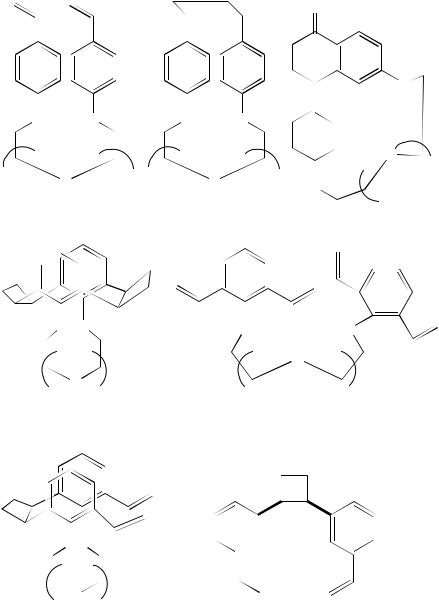
4. Photochemistry of non-conjugated dienes |
277 |
O
|
|
|
|
|
|
O |
O |
O |
O |
O |
|
|
|
|
|
|
|
|
O |
n |
|
|
|
|
|
||
|
n |
|
|
n |
|
|
|
O |
|
O |
|
O |
|
|
|
|
|
|
|
|
|
(127) |
(128) n = 3 or 4 |
(129) |
|
||
O O |
|
O |
O |
|
|
|
O |
O |
n |
|
n |
(130) n = 2 |
84% |
|
(131) n = 2 |
n = 3 |
92% |
|
n = 3 |
O O |
|
|
|
|
|
O |
n |
|
(132) n = 2 or 3 6% |
(133) |
|
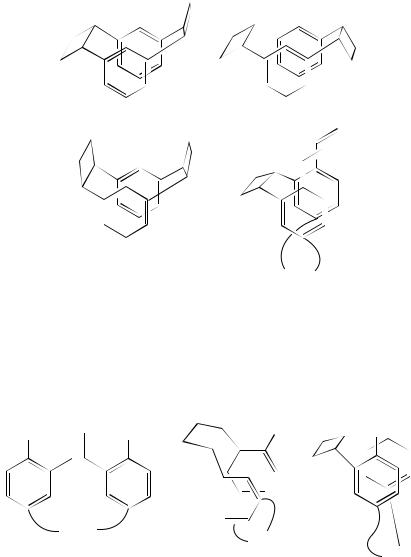
278 |
William M. Horspool |
(134) |
(135) |
(136)
(CH2)n
(137)
The aryl groups of the styryl systems need not be unsubstituted, as has been illustrated before for the cyclizations encountered in the synthesis of naphthalenophanes from 120. Indeed cyclization to afford a cyclobutane derivative where methoxy groups are on the adjacent ring position to the vinyl moieties has also been studied. The irradiation of 138 affords the m-cyclophanes 139 and 14065. Further study has sought to evaluate the steric effect of o-methoxy groups in such molecules66.
OMe
OMe |
|
|
|
OMe |
OMe |
MeO |
|
|
|
||||||
|
|
|
|
|
|
|
|
|
|
|
|
|
|
|
|
MeO

(CH2)n
(CH2)n
(CH2)n
(138) |
(139) |
(140) |
n = 2−6
C. Other Cycloadditions
1. Open-chain Systems
Before illustrating the scope of this method for the synthesis of complex structures, there are examples in the literature where non-conjugated dienes are in open-chain systems but
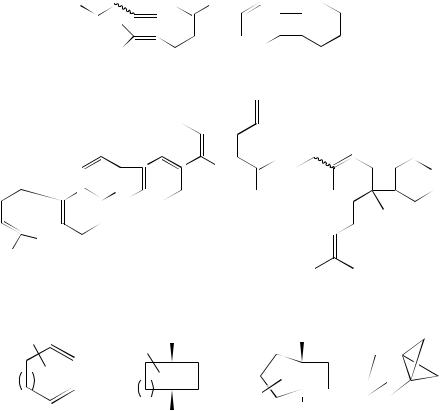
4. Photochemistry of non-conjugated dienes |
279 |
also undergo such (2 C 2)-cycloaddition reactions. Typical of this is the irradiation of the tetraene 141 that yields the bicyclooctene 14267. This cycloaddition probably involves excitation of the diene component and it is the excited state of this that adds to the terminal alkene. In the more complex system 143 the conjugated triene component is the most likely chromophore of the heptaene that will be excited. Addition within this molecule also occurs to an isolated double bond to yield the product 144. Cycloaddition to form a cyclobutane derivative is also observed as a result of mercury-sensitized vapourphase photolysis at 254 nm of the fluorinated diene 145. This yields the two cyclobutane derivatives 146 and 147 as well as the cross-addition product 148 in ratios of 5.7 : 1.0 : 2.8. When the reaction system was diluted with nitrogen the formation of the (2 C 2)- cycloadducts became dominant. Similar additions were observed for the diene 149. The straight (2 C 2)-adduct 150 and the cross-addition product 151 are formed in a ratio of 1 : 468. One of the double bonds can be contained within a ring as in the cycloaddition encountered in the study of cyclopropene (152). Sensitized irradiation affords the tricyclic compounds 153 by a head-to-head (2 C 2)-cycloaddition69.
(141) |
(142) |
(143)
|
|
|
|
|
|
|
(144) |
|
Fx |
|
Fx |
F |
|
F |
|
|
|
|
|
|
|
|
|
|
n |
|
|
n |
F10 |
|
|
|
|
|
|
|
F12 |
||
|
|
|
|
|
|
||
|
|
|
|
F |
|
F |
|
(145) |
n = 2, |
x = 12 |
(146) |
n = 2, |
x = 10 |
(147) |
(148) |
(149) |
n = 1, |
x = 10 |
(150) |
n = 1, |
x = 8 |
|
|
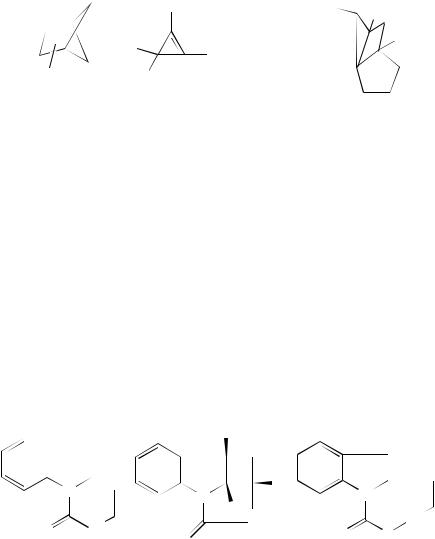
280 |
|
William M. Horspool |
|
|||
|
|
Ph |
|
Me |
Me |
|
|
|
|
Ph |
|||
|
|
|
|
|
|
|
|
|
R |
|
|
R |
|
|
Me |
|
|
|
|
|
F10 |
(CH2)3C |
|
CH2 |
|
||
|
|
|
||||
|
|
|
||||
|
Me |
|
|
|
||
|
|
|
|
|
||
(151) |
|
(152) (a) R = H |
|
|
(153) |
|
|
|
(b) R = Me |
|
|
|
|
(2 C 2)-Cycloadditions have also been reported for the indole derivatives 154 as an effective method for the synthesis of the polycyclic adducts 155. The yields, as can be seen from those quoted, range from moderate to good. The quantum efficiencies for the cyclizations are also reasonable. Interestingly, the ester derivatives 156 are photo-unreactive70,71. Head-to-head (2 C 2)-cycloaddition is also observed on irradiation of the diallylic amines 157. This yields the cyclobutanes 158. The reaction is diastereoselective and detailed semi-empirical calculations supported the proposed mechanism for the formation of these products72,73. The silyl ethers 159–161 are reactive by a (2 C 2)-cycloaddition in the singlet state while sensitization only brings about trans –cis isomerization. Irradiation of 159 brings about cyclization to cyclobutane derivatives. Thereafter the silyl ethers groups can be cleaved to afford cyclobutane diastereoisomers such as 162. It is interesting to note that in the cycloaddition of 159, R D cyclopropyl leading to 162, R D cyclopropyl, the cyclopropane ring remains intact. This presumably gives information about the intermediates involved in the cycloaddition and any cyclopropyl methyl radical species that could be formed is not sufficiently long-lived to undergo ring-opening. Cycloaddition can also occur to the furan double bond of 160 and to the alkyne moiety in 161 to yield, in this instance, cyclobutene derivatives74,75. In other dienes where the alkene moieties are held more rigidly within the tethered system, as with 163, irradiation readily affords the cyclobutane derivative 16476.
|
|
|
|
|
H |
|
|
|
|||
|
N |
|
|
|
|
|
H |
|
|
|
|
|
|
|
|
|
|
|
|
|
|
||
|
|
|
N |
H |
|
|
N |
|
|||
|
|
|
|
|
|
|
|||||
|
|
|
|
|
|
|
|
||||
|
|
|
|
|
|
|
|
(CH2)n |
|||
|
|
|
|
|
|
|
|||||
O |
(CH2)n |
|
(CH2)n |
|
|||||||
O |
|
|
|
O |
O |
||||||
|
|
|
|
|
|
|
|
|
|
|
|
(154) |
|
|
(155) |
|
|
|
(156) |
|
|
||
|
|
|
n = 1 |
29% |
f = 0.0078 |
|
|
|
|||
|
|
|
n = 2 |
92% |
f = 0.017 |
|
|
|
|||
|
|
|
n = 3 |
25% |
f = 0.0032 |
|
|
|
|||
Intramolecular (2 C 2)-photocycloaddition has proved to be an excellent route to the synthesis of the so-called cage compounds. Ideally, this route utilizes substrates where the two alkene moieties are held face-to-face within a pre-formed structure. The irradiation brings about excitation and coupling of the two groups to afford a cyclobutane ring.
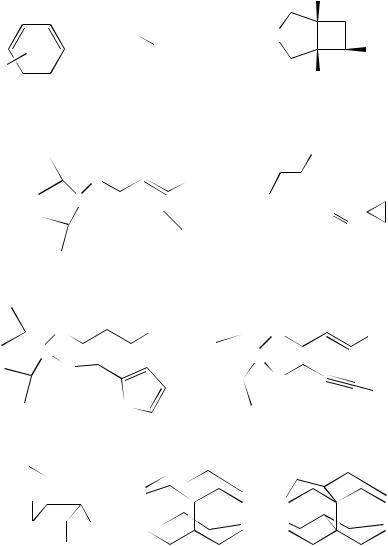
|
|
4. Photochemistry of non-conjugated dienes |
281 |
|||||||||||||
|
|
|
|
|
|
|
|
|
|
|
|
|
|
H |
|
|
|
|
|
|
NH |
HN |
|
|
|||||||||
|
|
|
|
|
|
|
|
|
|
Ar |
||||||
R |
|
|
|
|
|
|
|
|
|
|
|
|
|
H |
|
|
|
|
|
|
|
|
|
|
|
|
|
|
|
|
|||
|
|
|
|
|
|
|
|
|
|
|
|
|
|
|
|
|
|
|
|
(157) |
|
|
|
|
|
|
(158) |
|
|
||||
|
R = H, 4-F, 4-Cl, 4-NO2, 3-Cl, 2-F |
|
|
|
Ar = RC6H4 |
|||||||||||
|
|
O |
|
|
|
|
Ph |
R = |
|
|
|
, |
Ph |
|||
|
|
|
|
|
||||||||||||
|
|
Si |
|
|
|
|
|
|
|
|
|
|
|
Ph |
||
|
|
|
|
|
|
|
|
|
|
|
|
|
|
|
|
|
|
|
OCH2 |
|
|
|
|
|
R |
|
|
|
|
, |
|
CH |
|
|
|
|
|
|
|
|
||||||||||
|
|
|
|
|
|
|
|
|
|
|||||||
|
|
|
|
|
|
|
|
|
|
|
|
|
|
|
||
|
|
|
|
|
|
|
|
|
|
|
|
|
|
|
|
|
|
|
|
(159) |
|
|
|
|
|
|
|
|
|
|
|
|
|
|
|
O |
|
Ph |
|
O |
|
Ph |
||||||||
|
Si |
|
|
|
|
|
|
|
Si |
|
|
|
|
|
|
|
|
|
O |
|
|
|
|
|
|
|
|
|
|
|
|
|
|
|
|
|
|
|
|
|
|
|
|
O |
|
|
||||
|
|
|
|
|
|
|
|
|
|
|
|
|
||||
|
|
|
O |
|
|
|
|
|
|
R |
||||||
(160) |
|
(161) |
|
|
||||||||||||
|
|
|
|
|
|
|
|
|
|
|||||||
|
|
|
|
|
|
|
|
|
|
R = Ph, CO2Me |
||||||
HO |
|
|
|
|
|
|
|
|
|
|
|
|
|
|
||
HO |
|
S |
|
|
|
|
S |
S |
|
S |
||||||
|
|
|
||||||||||||||
|
|
|
|
|
|
|
|
|||||||||
|
|
|
|
|
|
|
|
|
||||||||
|
|
Ph |
|
S |
|
|
S |
S |
|
S |
||||||
|
|
|
|
|
||||||||||||
|
|
R |
|
|
|
|
|
|
|
|
|
|
|
|
|
|
(162) |
(163) |
|
(164) |
|||||||||||||
Such compounds are of use in the study of ring strain and also in synthetic approaches to starting materials for more complex systems. Several review articles have highlighted this77. The ring systems formed by these reactions are generally quite complex. In order to classify the reactions, a simple approach has been adopted. Not all the complexity is described in this nomenclature and only the atoms involved in the ring system formed are included.

282 |
William M. Horspool |
2. Bicyclo[2.1.0]pentane systems
An example of this type of ring system is given by the photochemical cyclization observed within the hydrocarbon 165. Irradiation converts it into the tetracyclic isomer
16678.
H
H
(165) |
(166) |
3. Cubanes and related compounds
Only a trace of the corresponding cubane 167 is formed on irradiation of the tricyclooctadiene 168 in pentane at ambient temperatures using a 125-watt mercury arc lamp. The principal product 169 is the result of rearrangement within a biradical intermediate79. A review of the synthetic approaches to cubane and to its reactions has been published77. The diene 170 photochemically converts on irradiation in pentane solution at 254 nm to yield a photostationary mixture of the cubane 171, the starting material 170 and the isomeric diene 17280. Other additions of this type have been used for synthesis of the propellaprismane 173, essentially a heavily substituted cubane, by the intramolecular (2 C 2)-photocycloaddition of the diene 17481.
|
|
|
|
|
|
|
(168) |
|
|
|
|
|
||
|
|
|
|
|
|
|
|
|
|
|
|
|||
|
|
|
|
|
|
|
|
|
|
|
|
|||
|
|
|
|
|
|
|
|
|
|
|
|
|||
|
|
|
|
|
|
|
|
|
|
|
|
|||
|
|
(167) |
|
|
(169) |
|
||||||||
|
|
|
|
|
|
|
|
|
|
|
|
|
|
|
|
|
|
|
|
|
|
|
|
|
|
|
|
|
|
|
|
|
|
|
|
|
|
|
|
|
|
|
|
|
|
|
|
|
|
|
|
|
|
|
|
|
|
|
|
|
|
|
|
|
|
|
|
|
|
|
|
|
|
|
|
|
|
|
|
|
|
|
|
|
|
|
|
|
|
|
|
|
|
|
|
|
|
|
|
|
|
|
|
|
(170) |
(171) |
(172) |
Less complex non-conjugated diene systems also lead to cubane-like derivatives as in the diene 175. Here the outcome of the reaction is dependent upon the excited state. Thus, direct irradiation brings about fragmentation with the formation of 1,4-difluorobenzene and excited-state naphthalene while triplet-sensitized irradiation follows a different path with the formation of the cage compound 17682.
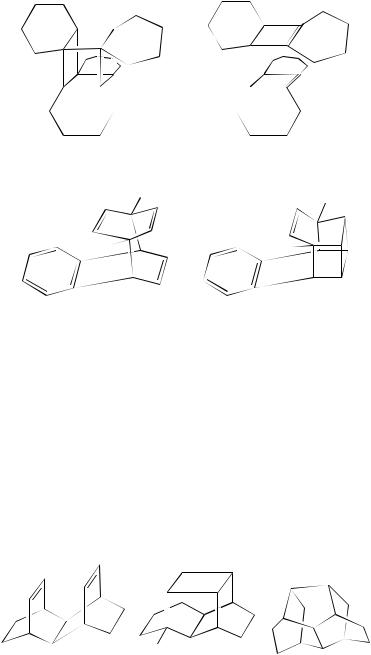
4. Photochemistry of non-conjugated dienes |
283 |
||
|
|
|
|
|
|
|
|
(173) |
|
(174) |
|
|
F |
F |
|
|
|
|
|
F |
|
F |
|
|
|
||
|
|
||
(175) |
|
(176) |
|
4. Hexacyclotetradecane systems
Normal (2 C 2)-photocycloaddition takes place on the acetone-sensitized irradiation of the per-ester 177 to yield the cage compound 178 in 76%. This product can be transformed chemically into the hexacyclotetradecane 17983. Analogously, the tetraene 180 undergoes photochemical cage formation yielding 18184. These cyclizations are typical of the type where the -moieties are held rigidly face-to-face within the framework. There are many examples of cycloaddition within such systems. A further example is the irradiation of the triene 182 through quartz in a mixture of acetone and benzene. The reaction is chemically efficient and the cycloaddition product 183 is formed in 80% yield85. Other cyclizations such as the formation of the cage compound 184 in 90% from direct irradiation of a benzene solution of the diene 185 and 186 from 187 have been reported86. The presence of hetero-atoms does not seem to effect the cyclization adversely and the irradiation of 188 results in a quantitative (2 C 2)-cycloaddition yielding 18987. The irradiation of 190 in acetone is also efficient. This irradiation presumably involves the triplet state and gives an almost quantitative yield of the cycloadduct 19188.
CO3Me |
CO3Me |
|
|
|
|
(177) |
(178) |
(179) |
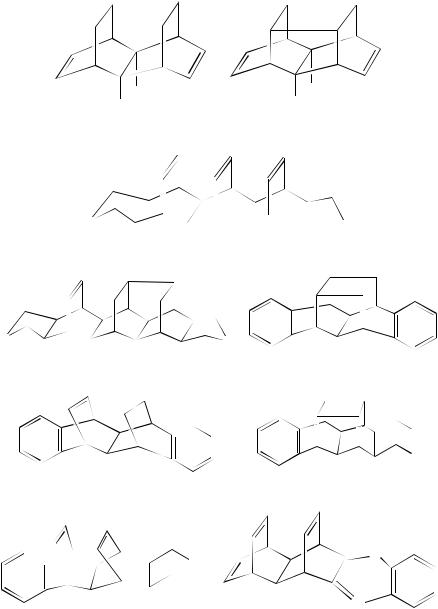
284 |
William M. Horspool |
|
|
|
|
|
|
|
H |
H |
H |
H |
(180) |
(181) |
O 


 O
O
(182)
|
|
|
|
|
|
|
|
|
|
|
|
|
|
|
|
|
|
O |
|
|
|
|
|
|
||
|
|
|
|
|
|
|||
O |
||||||||
|
|
|||||||
(183) |
(184) |
|||||||
|
|
|
|
|
|
|
|
|
|
|
|
|
|
|
|
|
|
OH
OH
(185) |
(186) |
N
|
OH |
|
OH |
|
N |
(187) |
(188) |
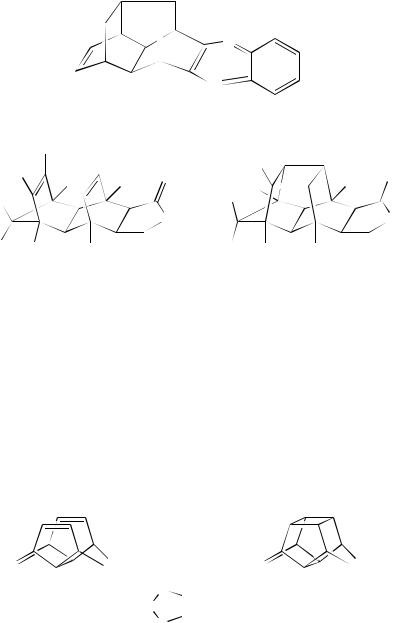
4. Photochemistry of non-conjugated dienes |
285 |
||
|
|
|
|
|
|
|
|
|
|
|
|
|
N |
|
|
|
|
|
|
|
|
|
|
N |
|
|
|
|
|
|
|
|
|
|
(189) |
|
|
|
|
|
Cl |
|
|
|
|
|
|
Cl |
|
||
|
|
|
|
|
|
|
|
|
|
|
Cl |
|
|
|
O |
|
Cl |
|
|
|
O |
|
|
|
|
|
|
|
|
|||
Cl |
OAc |
|
Cl |
OAc |
||||||
|
MeO |
|
||||||||
MeO |
|
|
|
|
|
|
|
|
||
|
|
|
|
O |
|
|
|
|
|
O |
MeO Cl |
|
|
|
MeO |
Cl |
OAc |
|
|
|
|
OAc |
|
|
|
|
|
|
||||
|
O |
|
|
|
O |
|
||||
(190) |
|
|
|
|
|
(191) |
|
|
|
|
5. Pagodanes and related molecules
It seems from the examples cited above that, provided the alkene moieties are held in a rigid framework, addition is often highly efficient. This is again demonstrated by the conversion of 192 into 193 or 194 into the pagodanes 195 by either direct irradiation in ether with a quartz filter or by acetone-sensitization through Pyrex89. Prinzbach and Weber77d have reviewed the synthesis of such compounds. A benzene ring can also be one of the components of the reaction system as demonstrated by the photo-ring closure of 196a into 197a. In the case of the resultant diene 197a, the remaining double bonds of the aromatic ring were trapped by Diels –Alder addition90. The bis arene 196b is also reactive and gives the cycloaddition product 197b91. Melder and coworkers92 have made use of such cycloadditions, using the slightly more substituted derivative 198, as a path to [1.1.1.1]pagodanes. Irradiation at 254 nm of 198 affords the (2 C 2)-cycloaddition product 199.
X |
X |
|
|
X |
X |
|
(192) |
O |
(193) |
||
|
X = CH2, C |
|
|||
|
, CO or C |
|
C(CN)2 |
|
|
|
|
|
|||
|
|
|
|||
|
|
O |
|
||

286
R1
R2
William M. Horspool
R1 |
R1 |
R1 |
R2 |
R2 |
R2 |
(194)
|
R |
|
R |
X |
X |
|
(195)
R1 = R2 = H
R1 = CO2Me, R2 = H R1R2 = O
R
R |
X



 X
X
(196) |
(a) |
X = CH2 or C |
O |
, R = H |
(197a) |
|
|||||
|
|
O |
|
(197b) |
|
(196) |
(b) |
X = CH2, RR |
=(CH |
CH)2 |
|
OMe |
OMe |
OMe |
|
OMe |
||
|
|
|
|
|
||
H |
H |
H |
|
H |
||
|
|
|
|
|
|
|
(198) |
(199) |
6. Peristylane and related molecules
Syntheses of the complicated structures such as the peristylane system 200, a 4[peristylane], can also be approached by (2 C 2)-photocycloadditions. Thus, irradiation of the
